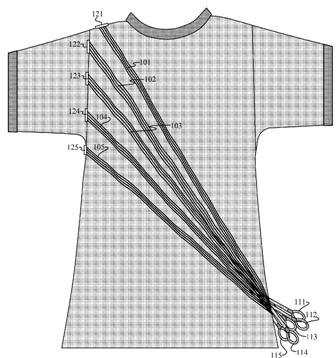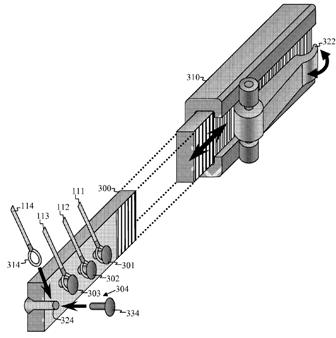The Next Great Advance in Golf Shirt Technology; Could It Be the Next Swimsuit Controversy?
Who says the Golf-Patents blog doesn’t cover fashion? OK, it really doesn’t, but last week a patent application published directed to golf shirt technology that is guaranteed (not really) to give you a higher swing speed, and probably significantly increase the number of times that you accidentally knock the ball of the tee!
The application published as US Pub. No. 20100088798 titled “Assisting Muscle Contraction for Enhancing Athletic Performance,” which explains:


A specialized article of clothing is configured to enhance speed and/or accuracy of a golf swing or baseball swing. The clothing employs tension and/or flexure members configured to enhance muscle function, thereby increasing muscular strength and/or speed for improving athletic performance. The tension and/or flexure members provide for storage and release of strain energy during a wearers movement. The article of clothing may be configured for alternative movements, including throwing, jumping, and running. The article of clothing may be adapted to reduce strain on fatigued or injured muscles, or it may be configured to limit the range of motion of a joint, such as to prevent injury.
[0007] In one aspect of the invention, an article of clothing comprises one or more tension and/or flexure members that can store and release energy to enhance movement. The tension and/or flexure members may comprise similar stiffness (modulus) values or different stiffness values, and are configured to store and release strain energy in at least one predetermined direction. Tension and/or flexure members may be oriented in a radial or parallel pattern. The tension and/or flexure members may be embedded within the clothing material (i.e., encapsulated, hidden) or may be located externally (i.e., outside the clothing material). The tension and/or flexure members are attached at specific locations to allow stretching (tensile strain) or deflection (flexural strain) for energy storage and release.
[0008] One aspect of the invention provides for an article of clothing comprising a tension means having a connection means configured for connecting the tension means to different sides of at least one joint, the tension means being configured for storing energy during a first movement of the at least one joint and releasing energy during a second movement of the at least one joint. For example, the second movement may be in opposition to the first movement.
[0009] The tension means may include, by way of example, but without limitation, one or more springs, bungies, rubber bands or chords, elastic panels, elastic threads, or any other type of elastic material. The connection means may include, by way of example, but without limitation, one or more connectors fixed to the article of clothing, and one or more connectors configured for coupling to an anchor means (such as a strap, a brace, a belt, or some other separate article of clothing). The connection means may comprise at least one connector configurable for attaching directly to an appendage of the wearer’s body. One or more of the connectors may be adjustable connectors.
[0010] Another aspect of the invention provides for an article of clothing comprising a flexure means having a connection means configured for connecting the tension means to different ends of at least one joint, the flexure means being configured for storing energy during a first movement of the at least one joint and releasing energy during a second movement of the at least one joint. The flexure means may include, by way of example, but without limitation, one or more semi-rigid rods, beams, tubes, panels, or skins configured to store strain energy when the flexure means is bent or otherwise deformed.
.
.
.
[0041] Regardless of initial pre-tension (or pre-flexure), additional storage energy is provided during the backswing portion of a golf swing or baseball bat swing. For example, in a golf swing, a great amount of forward swing power can be facilitated in the backswing by rotating the shoulders further than the hips (such as shown in FIG. 6). The shoulders rotate clockwise (for a right-handed golfer) by 90 degrees from the setup position shown in FIG. 6A to the full backswing position depicted in FIG. 6B, while the hips rotate only 45 degrees. Aspects of the invention may provide for stretching one or more tension members or flexing one or more flexure members during the backswing.[0042] The coiling (i.e., twisting) of the body (and the resulting tension and or flexure of a shirt or brace configured in accordance with aspects of the invention) during the backswing provide for potential-energy storage. This potential energy is released in the form of kinetic energy when the golfer’s body uncoils (untwists) during the downswing and follow-through (FIGS. 6B-6F), which accelerates the club head. Thus, some aspects of the invention provide for coordinating the release of stored tension (or flex) in tension elements (or flexure elements) with the uncoiling (i.e., untwisting) of the golfer’s body. Since aspects of the invention enhance potential-energy storage in the backswing position (FIG. 6), the speed of the downswing at impact with the golf ball (FIG. 6D) may be significantly increased.
[0043] Furthermore, aspects of the invention may employ an initial pre-tension and/or pre-flexure strain energy during setup (FIG. 6A), which provides for additional energy storage during the backswing (FIG. 6). Such pre-tension and/or pre-flexure assists the golfer in initiating the downswing from the top of the backswing, and increases the club head’s acceleration, thereby increasing club-head speed at the contact point (FIG. 6D), and thus driving distance.
While it would be interesting to see if this garment actually improved a golfer’s swing speed, is there any chance that it wouldn’t screw up your swing?
Dave Dawsey – The Fashion Patent Attorney (not)
